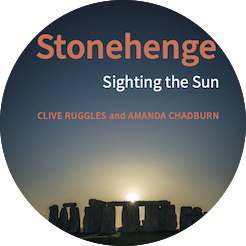Errata and clarifications
The following have come to light since the publication of the book:
Typographical errors
- p. 10 (Box 1.1), paragraph 3, line 1. “None could not” should read “None could”.
- p. 132, foot of page. There is a line missing, which should read “dark skies of Stonehenge pristine and unpolluted”.
Corrections
- p. 19 (Box 2.2), footnote ‘*’, line 1. For “(90–λ)°” read “λ°”.
- p. 19 (Box 2.2), footnote ‘§’. This should read: “The angle between the Earth’s axis and the direction perpendicular to the plane of its orbit — the so-called ‘obliquity of the ecliptic’ — is gradually decreasing. See Ruggles 2005, 317–19.”
- p. 95, last paragraph, line 1. For “south-western” read “north-eastern”.
- p. 149, note 24. “Thom and Thom (1974, 86)” should read “Thom et al. (1974, 86)”.
- p. 204, lines 1–2. This reference should read “Thom, Alexander, Archibald S. Thom and Alexander S. Thom 1974 ‘Stonehenge’. Journal for the History of Astronomy 5, 71–90” and hence be placed below the following reference.
Content clarifications
- p. 9, paragraph 2, line 9. The solstitial directions did not mark the boundaries of the four quarters of the Hopi cosmos, as the use of the word “demarcated” might suggest, but rather lay near their centres. The Hopi quadripartition of the cosmos differs from that of the Navajo (see p. 32), whose four quarters are centred upon the cardinal directions.
- p. 99, note 14. Since the x-values in Fig 6.6 refer to time intervals rather than dates, it would be clearer to re-word this note as follows: “It is the area under the curve (rather than the y-value) that is needed to calculate probabilities, which is why there are no numbers up the y- (vertical) axis. The total area under the curve is taken to be 1. Then, to calculate the probability (between 0 and 1) that the date difference (time interval between the construction of the timber settings and later henge at Woodhenge) falls in a particular range, drop vertical lines down from the curve at the smallest and largest values of that range to produce a “column” whose top is the curve. The probability is given by the area within the column. For example, if the area within the column is greater than 0.5 (50%), then it is more likely than not that the time interval falls in this range. Specific examples are included in the on-line materials.”
Index additions and clarifications
- dark sky xvi, 1. See also Light pollution.
If you come across anything else you think we should be aware of and list on this page, please contact us via the publisher. Thank you!
Other supplementary on-line materials
Errata and clarifications
